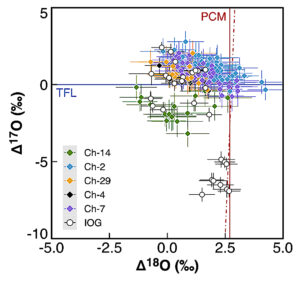Regnault, M. ; Marrocchi, Y. ; Piralla, M. ; Villeneuve, J. ; Batanova, V. ; Schnuriger, N. ; Jacquet, E.
Meteoritics & Planetary Science. (2022) 57, 1, 122-135
`Voir en ligne : https://doi.org/doi:10.1111/MAPS.13778

Abstract :
Rumurutiites (R chondrites) are rare, highly oxidized chondrites belonging to the noncarbonaceous superclan and characterized by low chondrule abundances. Although textural and chemical features of Rumurutiite chondrules resemble those of ordinary chondrites (OCs), their formation conditions and potential genetic link remain debated. Here, we report high-resolution elemental X-ray mapping analyses and in situ O isotopic measurements of olivine grains from five chondrules and eight isolated olivine grains (IOGs) in the NWA 12482 R3 chondrite. The chondrules show chemical zonings similar to their counterparts in ordinary and carbonaceous chondrites (CCs), implying that gas–melt interaction processes between chondrule precursors and SiO- and Mg-rich gas were operative throughout the circumsolar disk. Our isotopic data show that R chondrules are isotopically similar to ordinary chondrules, although differences in their abundances of relict olivine grains and chondrule textural characteristics suggest different formation environments, with R chondrules being formed from 16O-poorer precursors. As with chondrules in OCs, the O isotopic characteristics of R chondrules and IOGs suggest limited transport between CC and noncarbonaceous reservoirs.



